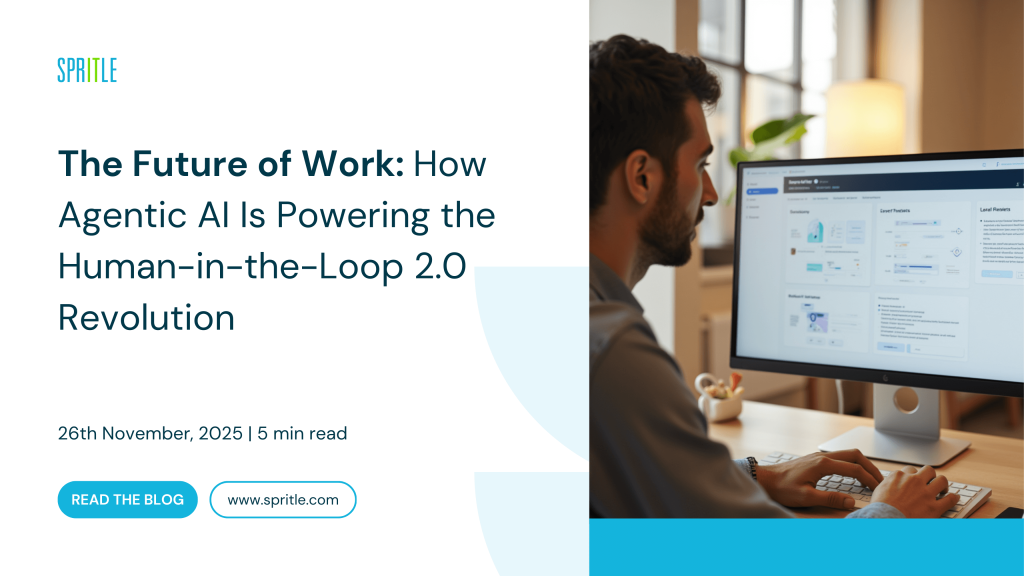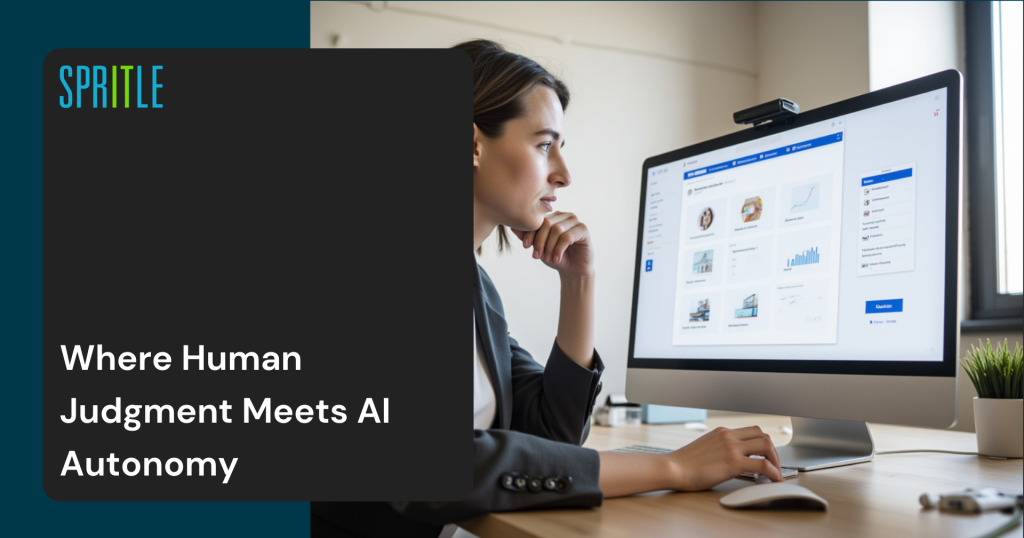
The conversation around artificial intelligence is shifting dramatically.
We’ve evolved beyond the binary narrative of humans versus machines. The new paradigm is human–AI orchestration, led by a new generation of Agentic AI systems — autonomous, reasoning, goal-driven agents that collaborate with humans instead of replacing them.
Welcome to the era of Human-in-the-Loop 2.0 — a world where humans no longer supervise AI from the sidelines but actively co-create, co-decide, and co-execute alongside it.
This isn’t just the next phase of automation.
It’s the dawn of a deeper partnership — Agentic AI orchestration — where human intent meets machine intelligence to deliver outcomes that neither could achieve alone.

🌍 What Is Agentic AI?
Before we dive deeper, it’s worth defining Agentic AI . Unlike traditional AI models that respond to static prompts, Agentic AI systems can reason, plan, and act toward achieving specific goals.
They’re built with autonomy and feedback loops, capable of adapting to changing contexts while still aligning with human-defined objectives. Think of them as intelligent digital collaborators — systems that interpret purpose, make decisions, and continuously learn from human interaction.
This shift transforms the traditional AI-human dynamic. Instead of humans simply prompting models for one-time outputs, Agentic AI allows continuous interaction, adaptation, and improvement — making collaboration fluid, contextual, and scalable.
💡 From Supervision to Co-Creation with Agentic AI
The first era of human-in-the-loop AI was primarily about supervision. Humans verified model outputs, corrected errors, and kept systems aligned with expectations. It was valuable but limited — more like managing an intern than collaborating with a peer.
Now, Agentic AI changes the game.
These agents can autonomously reason, plan, and execute tasks, drawing upon deep memory, contextual understanding, and feedback loops.
Instead of micromanaging, humans become strategic collaborators — co-designing outcomes, defining intent, and focusing on creativity, ethics, and innovation.
- Humans define the why and what.
- Agentic AI defines the how and when.
We’re not losing control; we’re gaining leverage. This evolution marks the move from oversight to orchestration — a new form of co-intelligence that learns, adapts, and improves through interaction.
⚙️ The New Division of Labor: Human + Agentic AI
Humans Bring:
- Context — Understanding nuance, goals, and strategy.
- Creativity — Designing new ideas, products, and experiences.
- Ethics — Ensuring fairness, safety, and human values guide the system.
- Empathy — Building trust, relationships, and meaning in every interaction.
Agentic AI Brings:
- Speed — Executing and learning at machine scale.
- Scale — Handling massive data sets and parallel tasks.
- Memory — Retaining and contextualizing information across workflows.
- Precision — Performing with consistency and analytical depth.
Together, they form a hybrid intelligence loop — one that merges human imagination with machine execution. The result is a self-improving ecosystem where both parties continuously learn from each other.
This is Human-in-the-Loop 2.0, powered by Agentic AI — a true partnership of cognition and computation.
🧠 Real-World Co-Creation with Agentic AI
1. Product Design Teams
Imagine product designers collaborating with Agentic AI systems that can instantly generate hundreds of design variations, simulate user experiences, and even test emotional resonance through predictive models.
Humans then step in — not to fix errors, but to select, refine, and elevate the versions that align best with brand vision and human emotion.
This co-creative process amplifies creativity while maintaining human judgment at the center.
2. Operations and Workflow Automation
In traditional automation, systems performed repetitive actions.
But Agentic AI introduces adaptive workflows. Agents can assess data streams, make independent operational decisions, and alert humans only when nuance, ethics, or strategy is required.
The result: human teams focus on leadership and innovation, while Agentic AI ensures execution excellence — continuously learning from each iteration.
3. Healthcare and Research
In healthcare, Agentic AI agents act as intelligent collaborators. They surface insights from patient data, identify correlations invisible to human eyes, and generate potential hypotheses.
Doctors, in turn, interpret these findings through empathy and contextual understanding, ensuring that care decisions are humane, ethical, and emotionally attuned.
The outcome isn’t replacement — it’s amplification. AI amplifies cognition, while humans preserve compassion.
🔄 From Prompts to Processes: Designing Around Agentic AI
The evolution from “prompt engineering” to “process orchestration” is one of the biggest mindset shifts in the AI era.
We used to treat AI as a tool that needed explicit prompts. Now, Agentic AI functions as an autonomous collaborator that can take broad goals and translate them into multi-step processes.
Here’s the difference:
| Traditional AI | Agentic AI |
| Responds to commands | Understands objectives |
| Works in isolation | Operates in ecosystems |
| Executes once | Iterates and improves |
| Needs supervision | Seeks alignment |
Agentic AI systems work within defined guardrails but possess the freedom to explore multiple pathways to reach desired outcomes. Humans set intent, define ethics, and review critical decisions — while the system adapts and improves in real time.
This approach creates dynamic, self-correcting processes that scale exponentially without losing human oversight or moral direction.
🕹️ Agentic AI and the Future of Work
The companies that will thrive in the coming decade aren’t those that automate the most; they’re those that collaborate the best — orchestrating fluid, real-time synergy between human teams and Agentic AI systems.
This shift redefines roles across every domain:
- Leaders will move from managing people to designing collaboration frameworks between humans and AI.
- Employees will focus more on creativity, empathy, and strategy.
- Agentic AI will handle execution, monitoring, and iteration, freeing humans from routine decision fatigue.
The outcome is a new form of productivity — one rooted in symbiosis, not substitution.
The New Skillset: Orchestrating Intelligence
Future professionals won’t just learn how to prompt AI — they’ll learn how to orchestrate intelligent ecosystems.
This means:
- Designing workflows where human intent drives autonomous execution.
- Building ethical and interpretive checkpoints.
- Continuously evolving the collaboration process itself.
In this world, success will depend not on how much work we offload to AI, but on how intelligently we co-evolve with it.
🧭 Ethical Compass: Ensuring Responsible Agentic AI
As Agentic AI systems gain autonomy, ethical alignment becomes paramount.
Who decides what “good” looks like? How do we ensure accountability when machines act independently?
The answer lies in Human-in-the-Loop 2.0 — continuous co-evaluation.
Humans remain the ethical and interpretive anchor. We design AI systems that are transparent, explainable, and auditable. Agentic AI, in turn, must be trained to seek feedback, respect constraints, and align with moral reasoning — not just efficiency metrics.
True progress doesn’t come from unchecked autonomy. It comes from responsible co-creation, where technology amplifies human values instead of overriding them.
🚀 Case Studies: Early Wins of Agentic AI Collaboration
🌐 Creative Industries
In advertising and film, Agentic AI tools now assist in storyboarding, editing, and audience sentiment analysis. Human creators guide narrative tone and emotion, while the AI iterates story arcs, pacing, and visuals — reducing production time dramatically.
🏢 Enterprise Workflows
Large organizations deploy Agentic AI systems to monitor supply chains, customer service interactions, and product development cycles. These agents not only automate routine checks but also identify anomalies, predict bottlenecks, and suggest process optimizations autonomously.
🧬 Scientific Research
In research labs, scientists co-design experiments with Agentic AI that can run simulations, optimize hypotheses, and even flag ethical risks before experiments begin.
This accelerates discovery cycles while preserving scientific integrity.
🌟 The Productivity Revolution: Collaboration over Automation
For years, the world obsessed over automation — replacing human labor with algorithms.
But the real revolution lies in collaboration — blending human creativity with the autonomous reasoning of Agentic AI.
We’re moving from an age of tools to an age of teammates.
AI is no longer something we use; it’s something we work with.
The next productivity leap won’t come from faster computation — but from smarter orchestration.
The companies that master this will unlock unprecedented agility, innovation, and resilience.
🔮 The Future Is Human + Agentic AI
The future of work isn’t Human vs. AI.
It’s Human + Agentic AI — a symbiotic partnership where each complements the other.
- Humans guide vision and ethics.
- Agentic AI executes, adapts, and scales.
Together, they form a loop of perpetual learning — a co-evolving intelligence that transcends what either could achieve independently.
So as we step into this new frontier, let’s not fear autonomy — let’s design for harmony.
Because the future isn’t about control; it’s about collaboration with intent.
✨ Final Thoughts: Orchestrating Tomorrow
Agentic AI marks the beginning of a new design philosophy — one where technology is not a substitute for human effort but a multiplier of human potential.
At Spritle, we believe this fusion defines the next decade of innovation.
From smarter teams to adaptive systems, from AI copilots to creative agents — the goal isn’t just to work faster, but to work together.
The future belongs to organizations that understand this balance —
those who don’t just automate tasks but orchestrate intelligence.
🤝 Crafted with curiosity by Spritle — building the future where humans and Agentic AI work as one.
